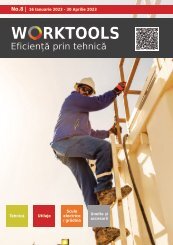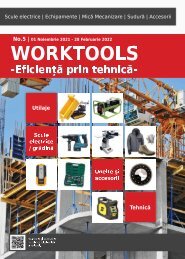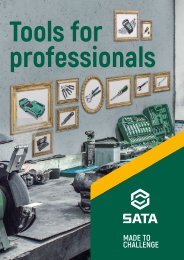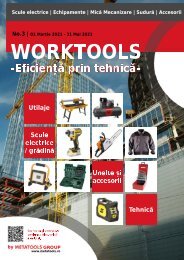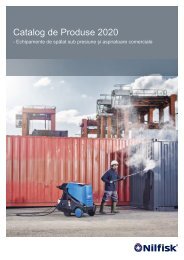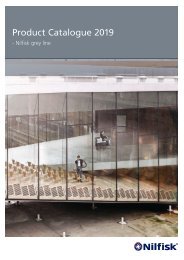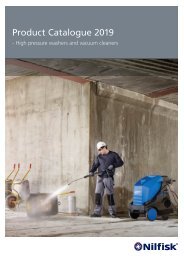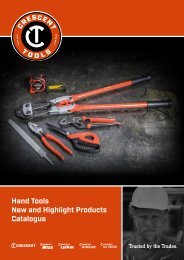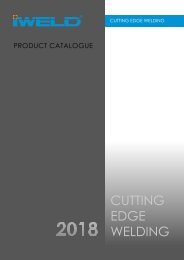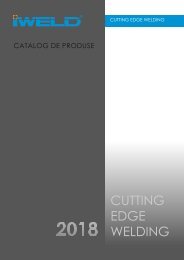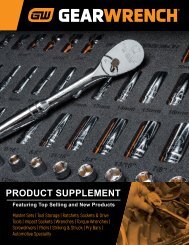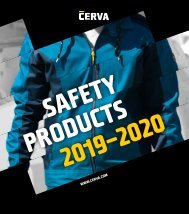Create successful ePaper yourself
Turn your PDF publications into a flip-book with our unique Google optimized e-Paper software.
PRESSURE REGULATORS<br />
A Pressure Regulator is a device for regulating a generally variable inlet pressure to an as constant as possible outlet pressure.<br />
(<strong>EN</strong> ISO 2503)<br />
By name and definition, a pressure regulator is simply a kind of valve designed to regulate and stabilize system pressure downstream of its placement.<br />
The gas cylinder content is consumed stepwise during the operation and thus the pressure upstream of regulator varies from full cylinder pressure to<br />
values close to zero. The task of the pressure regulator is to cope with such variation and maintain outlet parameters as stable as possible.<br />
REGULATOR PRINCIPLE<br />
A pressure regulator maintains downstream pressure by automatically modulating the level of the regulator encapsulated valve opening and gas stream<br />
throttling.<br />
By changing the area of opening as upstream pressures and downstream flow-rate vary, pressure drop through the encapsulated valve changes proportionally<br />
to maintain the downstream pressure at a relative constant level and relatively independent from remaining cylinder content and - to some extent –<br />
independent to gas amount consumed.<br />
Heart-valve opening or closing is driven and actuated by forces balance on regulator diaphragm. Ideally all forces caused by inner pressure<br />
conditions and forces generated by spring compression become perfectly balanced and the encapsulated valve seat allows just the requested quantity of<br />
gas to expand into the low pressure chamber causing a steady, constant pressure gas stream.<br />
In reality all conditions fluctuate and the heart-valve spindle constantly moves up or down to reflect changing conditions and regulate the opening<br />
appropriately. For that reason the proper design of diaphragm, right choice of heart-valve geometry and high-grade materials are key in regulator<br />
unctionality and reliability. <strong>GCE</strong> utilize its more than 70 years of experience in regulator business to optimize product design and choose optimal<br />
technical solutions.<br />
PRODUCT SELECTION<br />
To ensure a suitable level of accuracy in pressure maintenance and provide demanded gas flow-rate there are various models of pressure regulators<br />
available to meet specific flow and pressure requirements. To ensure the regulator functions correctly and thus a steady and sufficient gas supply, the<br />
user should always observe and consider the operating parameters before purchase of product. Your basic selection criteria should be at least the<br />
following:<br />
GAS MEDIA<br />
GAS PRESSURES<br />
GAS FLOW<br />
PRESSURE STABILITY<br />
The intended working gas selection<br />
affects not only connection style but<br />
even inner design of the regulator<br />
and material compatibility of<br />
product with selected media. Never<br />
use regulators with other gases<br />
than specified by product marking<br />
even if inlet connection would<br />
allow. Such misuse could result in<br />
product damage and in potential<br />
health and safety hazards.<br />
Consider the pressure range<br />
available on cylinder side and mainly<br />
the pressure requested on regulator<br />
output. Standard cutting, welding<br />
or heating operations can be<br />
served by UNI/S2+ regulator series<br />
but even for special high pressure<br />
applications the JETCONTROL 600/S<br />
Series is available. Due to safety<br />
reasons all <strong>GCE</strong> regulators have<br />
maximum outlet pressure restricted<br />
close to nominal value stated in<br />
catalogue so pay attention for the<br />
right selection.<br />
Not only gas pressure, but also<br />
expected gas amount is equally<br />
important when selecting correct<br />
regulators. Capacity of gas source<br />
should also be considered. <strong>GCE</strong><br />
provide a comprehensive range of<br />
regulators which covers the needs<br />
of most industrial applications.<br />
The pressure stability of the<br />
regulator is mostly affected by<br />
product size and design. Larger<br />
diameter of diaphragm dramatically<br />
improves stability. In many specific<br />
cases only S2+ MULTISTAGE<br />
regulator can provide ultimate<br />
stable pressure supply. If in doubt<br />
consult your <strong>GCE</strong> experts for the<br />
best selection.<br />
Control Knob<br />
Main Spring<br />
Diaphragm<br />
Encapsulated Valve<br />
Inlet Connection<br />
Pressure Relief Valve<br />
SAFETY<br />
Despite <strong>GCE</strong> designers and engineers paying the upmost attention to pressure<br />
regulator safety, there is still a big responsibility only on the end user. Pressure<br />
regulators are devices dealing with high gas pressures and – especially in<br />
cutting and welding applications – dealing with gases which can be potentially<br />
dangerous. Any contamination of oxygen washed surfaces by hydrocarbons<br />
(oil, grease, organic substances etc.) can lead to fire or explosion so cleanliness is<br />
of paramount importance for maintaining safe working conditions. Mechanical<br />
damage of connection components can result in leakage or release of broken<br />
particles and consequential damage of system. Potential leakage of flammable<br />
gases, especially if leaking gas accumulates, sooner or later results in ignition<br />
and fire. High attention must be paid to the condition of the regulator safety<br />
valves.<br />
<strong>GCE</strong> regulators are robust and durable devices but appropriate handling,<br />
maintenance and care are necessary for their safe and reliable operation. Read<br />
and follow all recommendations mentioned in Instruction for Use provided<br />
with the product.<br />
8





